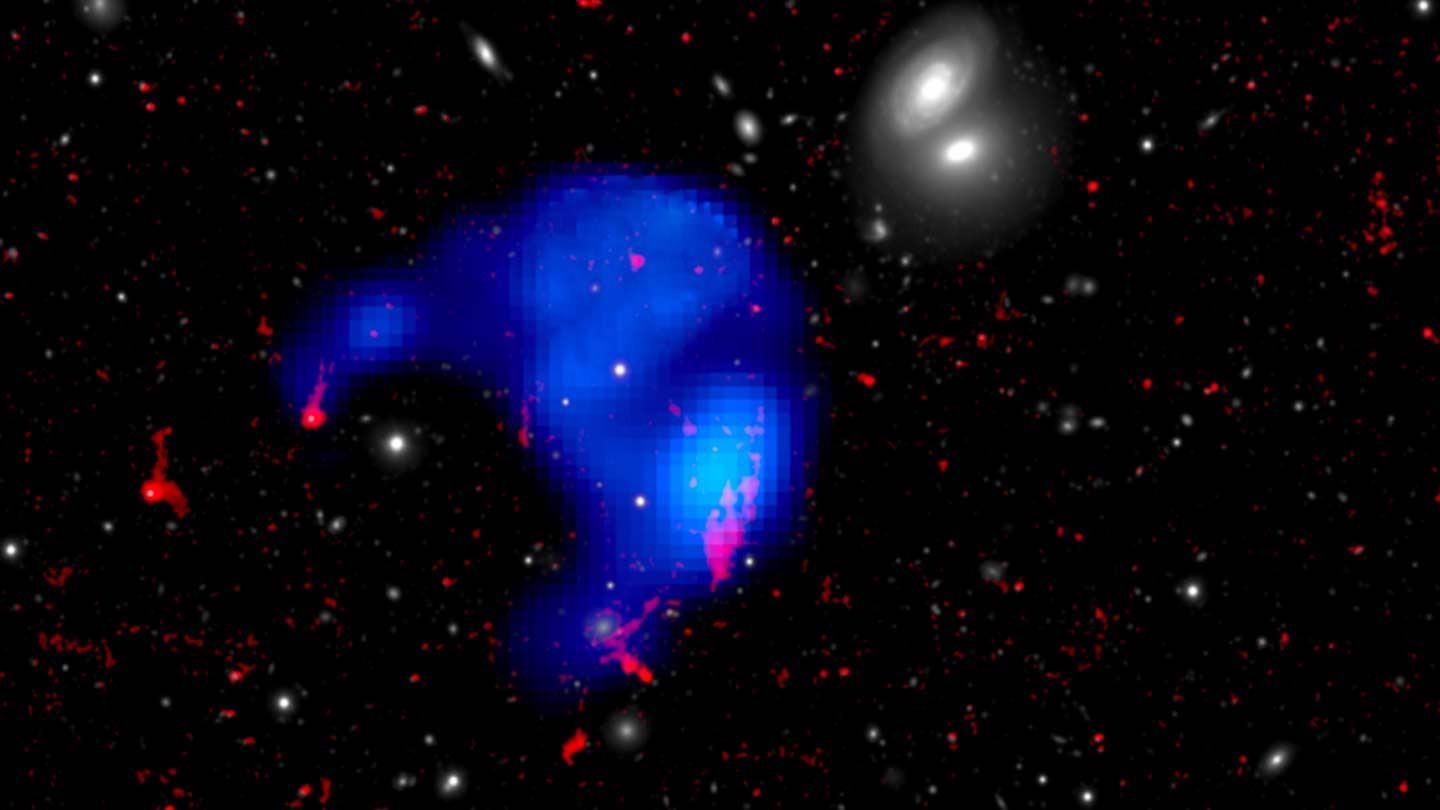Jul 1 2021
At The University of Alabama in Huntsville (UAH), a research group has discovered a scientifically mysterious, detached cloud bigger than the Milky Way in a “no man's land” for galaxies.
 The orphan cloud is the blue umbrella-shaped part of this image, which is color-coded to show the X-ray part of the cloud in blue, the warm gas in red and the visible region in white. Image Credit: European Space Agency / XMM-Newton.
The orphan cloud is the blue umbrella-shaped part of this image, which is color-coded to show the X-ray part of the cloud in blue, the warm gas in red and the visible region in white. Image Credit: European Space Agency / XMM-Newton.
The alleged lonely or orphan cloud has been filled with hot gas of temperatures ranging from 10,000 to 10000000 K and a complete mass 10 billion times that of the sun. This makes it bigger compared to the mass of small galaxies.
The discovery of the cloud was achieved in Abell 1367 by a team headed by Dr. Ming Sun, an associate professor of physics at UAH, which is a part of the University of Alabama System. Also known as the Leo Cluster, A1367 consists of approximately 70 galaxies and is situated nearly 300 million light-years from Earth.
The study was headed by Dr. Ming’s UAH postdoctoral researcher, Dr. Chong Ge, and the second author is also his postdoctoral researcher, Dr. Rongxin Luo. Dr. Sun is the third and corresponding author of the. The study also includes Tim Edge (MS, physics, 2019), who currently works at Dynetics Inc.
The cloud was discovered with the help of the European Space Agency (ESA) X-ray Multi-Mirror Mission (XMM-Newton), Europe’s flagship X-ray telescope. Moreover, the cloud was observed using the European Southern Observatory Very Large Telescope or Multi-Unit Spectroscopic Explorer (VLT/MUSE) and Japan’s flagship optical telescope, Subaru. A picture of the cloud is available on the ESA site.
This is an exciting and also a surprising discovery. It demonstrates that new surprises are always out there in astronomy, as the oldest of the natural sciences. Apparently, ESA agrees as our discovery was selected as an ESA image release, which has been very selective.
Dr. Ming Sun, Associate Professor of Physics, The University of Alabama in Huntsville
The X-ray image of the cloud was taken by XMM and the optical images were taken by Subaru and VLT/MUSE. Apart from the Subaru images, Dr. Sun is the principal investigator for the VLT/MUSE and XMM data.
Sun added, “The cloud was serendipitously discovered in our XMM data. The optical data come from our VLT/MUSE data and confirm the cloud is located in the cluster.”
According to Dr. Sun, the cloud was found in a cluster of galaxies where thousands of galaxies are linked with tenuous hot gas with temperatures of around 100000000 K present between them.
However, the cloud is not associated with any galaxy and is in a ‘no-galaxy’s land.’ The gas in the cloud is removed by ram pressure of the hot gas in the cluster, when the host galaxy is soaring in the hot gas with a velocity of 1,000-2,000 kilometers per second.
Dr. Ming Sun, Associate Professor of Physics, The University of Alabama in Huntsville
That is nearly 50 times quicker compared to the orbital speed of Earth around the sun. That level of force at work can tear the interstellar medium out of a galaxy, and in this instance, the scientists discovered that the cloud’s temperature is consistent with having originated from a galaxy. Dr. Sun added that the cloud most possibly originated from a large, unknown galaxy in the cluster.
It is like when your hairs and clothes are flying backward when you are running forward against a strong headwind. Once removed from the host galaxy, the cloud is initially cold and is evaporating in the host intracluster medium, like ice melting in the summer.
Dr. Ming Sun, Associate Professor of Physics, The University of Alabama in Huntsville
Still, it has been predicted that this huge, mysterious cloud has lasted for hundreds of millions of years following isolation from its host galaxy.
“This surprising longevity is poorly understood but may have something to do with the magnetic field in the cloud,” stated Dr. Sun.
The researchers believe that the field might serve by keeping the cloud together by inhibiting unsteady forces that would otherwise result in its dissipation.
Dr. Ming states that additional research could be helpful for scientists in finding the lonely cloud and others that are not yet known. Also, it might help gain better insights into the stripped interstellar mediums at huge distances from their galaxies, as well as the impacts of heat conduction and turbulence.
“As the first isolated cloud glowing in both the H-alpha spectral line and X-rays in a cluster of galaxies, it shows that the gas removed from galaxies can create clumps in the intracluster medium, and these clumps can be discovered with wide-field optical survey data in the future,” concluded Sun.
Journal Reference:
Ge, C., et al. (2021) An Hα/X-ray orphan cloud as a signpost of the intracluster medium clumping. Monthly Notices of the Royal Astronomical Society. doi.org/10.1093/mnras/stab1569.